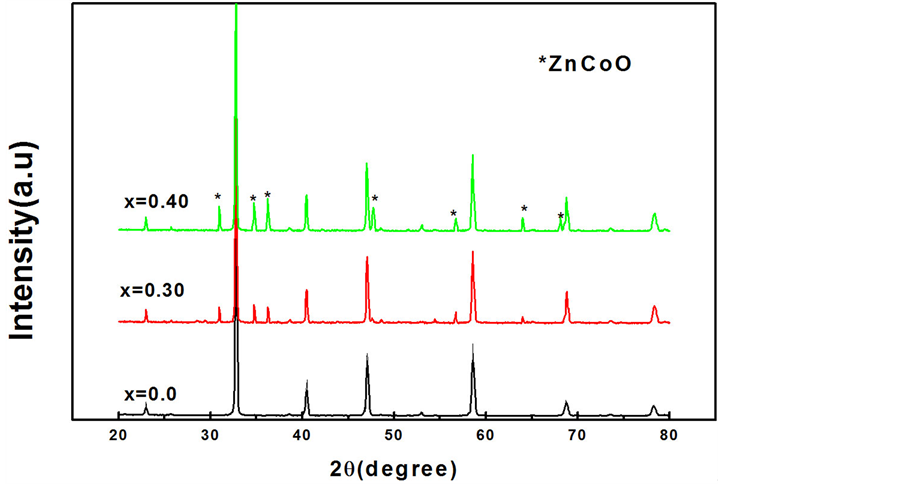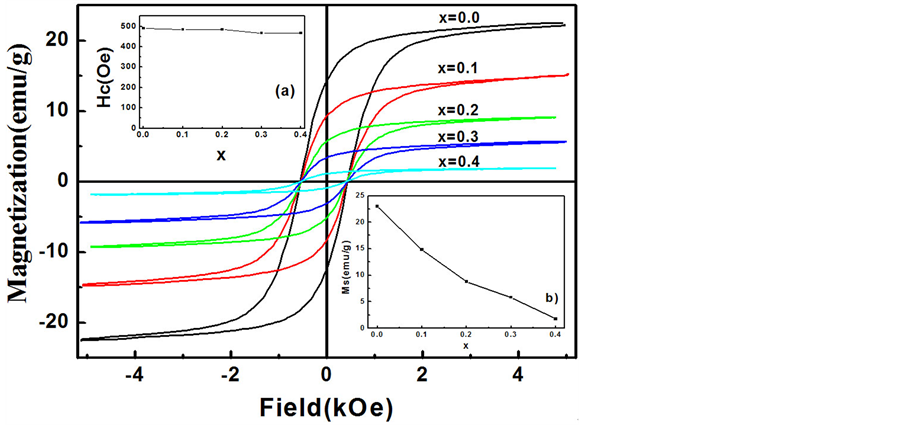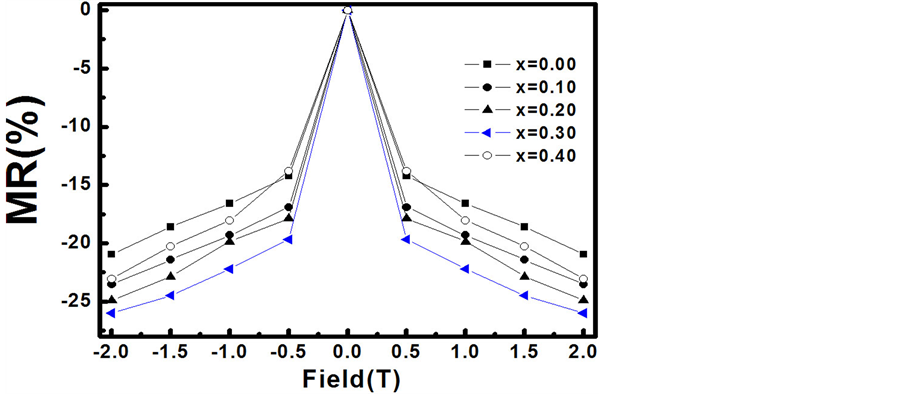Applied Physics
Vol.06 No.04(2016), Article ID:17410,6
pages
10.12677/APP.2016.64011
Electromagnetic Transport Properties of La0.7Sr0.3MnO3/xZn0.95Co0.05O Composite
Bin Zhuang, Guanzhong Huo, Liqun Xiong, Shuiyuan Chen, Yingbin Lin, Zhigao Huang*
Fujian Provincial Key Laboratory of Quantum Manipulation and New Energy Materials, College of Physics and Energy, Fujian Normal University, Fuzhou Fujian

Received: Apr. 5th, 2016; accepted: Apr. 20th, 2016; published: Apr. 25th, 2016
Copyright © 2016 by authors and Hans Publishers Inc.
This work is licensed under the Creative Commons Attribution International License (CC BY).
http://creativecommons.org/licenses/by/4.0/



ABSTRACT
Selecting high Curie temperature (Tc = 350 K) and high spin polarization La0.7Sr0.3MnO3 as magnetic phase, weak magnetic dilute magnetic semiconductor materials Zn0.95 Co0.05O as border material, La0.7Sr0.3MnO3:xZn0.95Co0.05O (x = 0.0, 0.1, 0.2, 0.3, 0.4 mol) composite was prepared by sol- gel method. The results measuring crystal structure and electromagnetic transport properties indicated that, boundary materials have effect on the magnetic resistance significantly; magnetic resistance increases with the x value; with small magnetic field, the low field's high magnetic resistance exists.
Keywords:La0.7Sr0.3MnO3, Zn0.95Co0.05O, Boundary Materials, Composite, Electromagnetic Transport

La0.7Sr0.3MnO3/xZn0.95Co0.05O复合体系的 电磁输运特性
庄彬,霍冠忠,熊力群,陈水源,林应斌,黄志高*
福建师范大学物理与能源学院,福建省量子调控与新能源材料重点实验室,福建 福州

收稿日期:2016年4月5日;录用日期:2016年4月20日;发布日期:2016年4月25日

摘 要
选取高居里温度(Tc约350 K)、高自旋极化率的La0.7Sr0.3MnO3为磁性相,弱磁性的稀磁半导体材料Zn0.95Co0.05O作为边界材料,采用溶胶-凝胶法制备La0.7Sr0.3MnO3:xZn0.95Co0.05O (x = 0.0, 0.1, 0.2, 0.3, 0.4 mol)复合体系。对样品的结构、电磁输运特性测量结果分析表明,边界材料对磁电阻的影响显著,x值增大导致磁电阻增加;当加上小磁场后,出现了低场下的高磁电阻。
关键词 :La0.7Sr0.3MnO3,Zn0.95Co0.05O,边界材料,复合体系,磁电输运

1. 引言
近年来,钙钛矿结构锰氧化物如La-Ca(Sr,Ba)-Mn-O3体系,尖晶石结构铁氧体如Fe3O4等,因具有丰富的磁、电特性:如与自旋极化相关的隧穿磁电阻效应、庞磁电阻效应、霍尔效应以及电致电阻效应等 [1] - [4] 而成为研究热点。在选择该类氧化物作为铁磁基体后,结合ZnO、CeO2等材料形成两相复合体更是激发了研究者们的兴趣 [5] - [10] ,以期通过表面效应和界面效应来改善复合材料的磁电阻特性。Zn0.95Co0.05O是稀磁半导体,不仅具有半导体的性质,同时还具有些新奇的磁特性 [11] [12] 。本文选取了高居里温度的La0.7Sr0.3MnO3作为铁磁相,配比不同比例的Zn0.95Co0.05O,形成La0.7Sr0.3MnO3/xZn0.95Co0.05O 复合材料,并测量了它们的结构、电阻和磁电阻特性等。实验表明,复合材料在绝缘体–金属转变温度附近MR值发生了明显改变,磁电阻效应明显增强。
2. 样品的制备
通过溶胶凝胶法制备了La0.7Sr0.3MnO3:xZn0.95Co0.05O (x = 0.0, 0.1, 0.2, 0.3, 0.4 mol)系列样品。利用超声对LSMO颗粒进行表面处理后,按x分别为0%、10%、20%、30%、40%的摩尔比将LSMO原粉和一定体积的Zn0.95Co0.05O溶胶混合,加入无水乙醇形成悬浊液后,超声清洗30 mins后于60℃水浴中直至水分全部蒸干。将上述工艺处理得到的粉末在10 MPa的压力下压成l cm的圆片,并在1050℃下常压保温10 h后随炉冷却至室温,从而获得名义组分为La0.7Sr0.3MnO3:xZn0.95Co0.05O (下文中简写为Zn0.95Co0.05O复合体系)。
3. 样品的晶体结构
采用MiniFlex-II X射线衍射仪(Cu靶,Kα线,λ = 0.15406 nm)进行结构分析,测量结果表明,母体材料LSMO具有良好的单相结构,没有可探测的杂相出现。然而,当x > 0.10时,出现了六角结构的Zn0.95Co0.05O相,且峰值强度随x的增加而逐渐增大。图1中给出了三个典型样品(x = 0.0, 0.20, 0.40)的XRD图谱,其中Zn0.95Co0.05O衍射峰(在图中用*表示)。结果发现,LSMO相和Zn0.95Co0.05O相没有发生偏移,LSMO和Zn0.95Co0.05O相之间并没有发生明显反应,Zn0.95Co0.05O只是作为第二相,分布在LSMO相的表面和界面,使系统形成了一种两相结构。
4. 样品的电、磁输运特性
利用振动样品磁强计(VSM-VersaLab)及磁电效应综合测试系统我们测量了样品的电、磁输运特性。

Figure 1. X-Ray diffraction patterns of three typical composites
图1. 三个代表性样品的X射线衍射图谱

Figure 2. Temperature dependence of the resistivity at zero field for the composites
图2. 零场下样品的电阻率随温度的变化关系
图2为升温过程中全部样品零场下的电阻率ρ随温度T变化关系图,可发现以下特征:所有样品均出现了金属–绝缘体转变温度(Tp),x = 0.0样品的Tp为278 K,x = 0.1到x = 0.4样品的Tp依次为272 K,266 K,263 K,261 K,这表明,随着包覆量x增加,复合样品的金属绝缘体转变温度逐渐降低。同时,随着x增大,复合体系的电阻率随之增加,这是高电阻率的Zn0.95Co0.05O表面效应作用的结果。弱磁性的Zn0.95Co0.05O在LSMO颗粒边界形成势垒,势垒的厚度随着x值增加,导致了电阻率增大。
图3为室温下所有样品的磁滞回线图。其中,插图(a)和(b)分别为每单位质量的La0.7Sr0.3MnO3的饱和磁化强度Ms和矫顽力Hc的变化关系图。从中可以看出,样品的Ms随着x值的增加迅速减少,而矫顽力Hc减少缓慢。这是因为随着Zn0.95Co0.05O颗粒嵌在铁磁颗粒表面,La0.7Sr0.3MnO3铁磁颗粒之间的距离增加,导致La0.7Sr0.3MnO3颗粒间的铁磁藕合减弱,随着Zn0.95Co0.05O含量的增加,颗粒间的铁磁有序削弱,而铁磁无序增强。
图4、图5分别为温度T = 120 K时,复合样品的磁电阻值MR随磁场强度H (最大磁场为20 koe)及在磁场强度为20 kOe下磁电阻(MR)随温度的变化关系图。对比发现,复合样品的磁电阻增加(相比纯LSMO),且在低场下(B = 5 kOe)、温度T = 120 K时,复合样品x = 0.10,0.20,0.30的磁电阻逐渐

Figure 3. Magnetic hysteresis loops at room temperature for the composites of La0.7Sr0.3MnO3:xZn0.95Co0.05O (x = 0.0, 0.1, 0.2, 0.3, 0.4). The inset (a) means the coercivity Hc at room temperature as a function of x; The inset (b) represents the saturated magnetization Ms at room temperature as a function of x
图3. 室温下La0.7Sr0.3MnO3:xZn0.95Co0.05O (x = 0.0, 0.1, 0.2, 0.3, 0.4)的磁滞回线。插图(a)为室温下矫顽力随着包覆量x的变化关系;插图(b)为饱和磁化强度Ms随着掺杂量x的变化关系

Figure 4. Magnetic field dependence of the magnetoresistance (MR) in a magnetic field (0 - 20 kOe) at 120 K for the composites
图4. T = 120 K下复合样品的磁电阻值MR随磁场强度B的变化关系

Figure 5. Temperature dependence of the magnetoresistance (MR) in a field of 20 kOe for the composites
图5. 复合样品在磁场强度为20 kOe下磁电阻(MR)随温度的变化关系
增强,相应的磁电阻值分别为16.9%,17.9%,19.8%,比x = 0时的14.24%有增加,然而,当x = 0.40时,磁电阻值明显减少(小于x = 0.1的磁电阻值),这是由于势垒层变厚,阻止了电子的自旋极化隧穿。这也进一步表明,电子在Zn0.95Co0.05O包覆层上的自旋极化隧穿是磁电阻提高的主要来源。一方面,当颗粒表面包覆上弱磁性的Zn0.95Co0.05O后,颗粒表面磁无序增强,传导电子在颗粒表面将产生自旋相关的隧穿过程,当加上外加磁场后,自旋无序受到抑制,表面原子排序逐渐趋于一致,增强了电子自旋极化隧穿,形成了低场下的磁电阻增强 [13] 。另一方面,颗粒表面的磁无序同时也增加了电子在边界处的磁畴散射 [14] - [16] 。在纯LSMO中,导电电子在每一个磁畴中基本上是极化的,并且容易在Mn3+和Mn4+离子对之间转移。然而,当这些传导电子在晶粒之间跃迁时,电子在晶粒边界/表面的自旋相关散射会导致高电阻率。当加上适当的低磁场时,可以使得晶界表面的原子磁矩和自旋取向趋于平行排列,导致电阻率下降和低场磁电阻的产生。因此,低温下的低场磁电阻的形成是由于电子在晶界处的自旋无序度得到增强,从而增强了电子的自旋极化隧穿几率。而自旋极化隧穿几率取决于Zn0.95Co0.05O层的厚度。
5. 小结
Zn0.95Co0.05O与LSMO所形成的复合材料,对样品的电磁特性和磁电阻特性有着显著的影响。随着Zn0.95Co0.05O嵌在LSMO晶粒表面,晶粒间距离增加,磁耦合减弱,从而导致了晶粒铁磁无序减弱,自旋无序增加。更重要的是,复合体系(x = 0.1, 0.2, 0.3)的磁电阻比x = 0.0有所增强,可见晶粒表面或边界材料对磁电阻的提高起了重要作用,电子通过自旋极化隧穿在晶界处形成自旋无序,当加上小磁场后,自旋无序受到抑制,从而导致了低场下(0.5 T)的高磁电阻的形成。
基金项目
国家重点基础研究发展计划(973)项目(批准号:2011CBA00200)、国家自然科学基金(批准号:60876069)、教育厅B类(JB14028)、福建省大学生创新创业计划项目(201510394051)资助的课题。
文章引用
庄 彬,霍冠忠,熊力群,陈水源,林应斌,黄志高. La0.7Sr0.3MnO3/xZn0.95Co0.05O复合体系的电磁输运特性
Electromagnetic Transport Properties of La0.7Sr0.3MnO3/xZn0.95Co0.05OComposite[J]. 应用物理, 2016, 06(04): 77-82. http://dx.doi.org/10.12677/APP.2016.64011
参考文献 (References)
- 1. Coey, J.M.D., Berkowitz, A.E., Balcells, L., et al. (1998) Magnetoresistance of Magnetite. Applied Physics Letters, 72, 734-736. http://dx.doi.org/10.1063/1.120859
- 2. Naftalis, N., Bason, Y., Hoffman, J., et al. (2009) Anisotropic Magnetoresistance and Planar Hall Effect in Epitaxial Films of La0.7Ca0.3MnO3. Applied Physics Letters, 106, Article ID: 023916.
- 3. Thiele, C., DÖrr, K., Bilani, O., et al. (2007) Influence of Strain on the Magnetization and Magnetoelectric Effect in La0.7A0.3MnO3/PMN-PT(001) (A=Sr, Ca). Physical Review B, 75, Article ID: 054408. http://dx.doi.org/10.1103/PhysRevB.75.054408
- 4. Chen, S.Y., Ye, Q.Y., Wang, D.H., et al. (2011) Effect of Electric Field on Magneto-Transport Properties in La2/3 (Ca0.6Ba0.4)1/3MnO3/Pb(Zr0.52Ti0.48)O3 Laminated Composite. Journal of Applied Physics, 109, Article ID: 07D723.
- 5. Das, D., Choury, P., Das, R.N., et al. (2002) Solution Sol-Gel Processing and Investigation of Percolation Threshold in La2/3Ca1/3MnO3:xSiO2 Nanocomposite. Journal of Magnetism and Magnetic Materials, 238, 178-184. http://dx.doi.org/10.1016/S0304-8853(01)00859-9
- 6. Barcells, L., Carrillo, A.E., Martinez, B., et al. (1999) En-hanced Field Sensitivity Close to Percolation in Magnetoresistive La2/3Sr1/3MnO3/CeO2 Composites. Applied Physics Letters, 74, 4014-4016. http://dx.doi.org/10.1063/1.123245
- 7. Kameli, P., Salamati, H., Eshraghi, M., et al. (2005) The Effect of TiO2 Doping on the Structure and Magnetic and Magnetotransport Properties of La0.75Sr0.25MnO3 Composite. Applied Physics Letters, 98, 43904-43908.
- 8. Lei, L.W., Fu, Z.Y., Zhang, J.Y., et al. (2006) Synthesis and Low Field Transport Properties in a ZnO-Doped La0.67Ca0.33MnO3 Composites. Materials Science and Engineering: B, 128, 70-74. http://dx.doi.org/10.1016/j.mseb.2005.11.023
- 9. Huang, Y.H., Yan, C.H., Luo, F., et al. (2002) Large Enhancement in Room-Temperature Magnetoresistance and Dramatic Decrease in Resistivity in La0.7Ca0.3MnO3-Ag Composites. Applied Physics Letters, 81, 76-78. http://dx.doi.org/10.1063/1.1491029
- 10. Yuan, X.B., Liu, Y.H., Wang, C.J., et al. (2006) Electronic Transport and Extra Large Magnetoresistance in LCBMO/ Pdx Composites. Journal of Physics D, 39, 1028-1033. http://dx.doi.org/10.1088/0022-3727/39/6/006
- 11. Wu, Q.Y., Chen, Z.G., Wu, R., et al. (2007) First-Principles and Monte Carlo Combinational Study on Zn1−xCoxO Diluted Magnetic Semiconductor. Solid State Communications, 142, 242-246. http://dx.doi.org/10.1016/j.ssc.2007.01.048
- 12. Dietl, T., Ohno, H., Matsukura, F., et al. (2000) Zener Model Description of Ferromagnetism in Zinc-Blende Magnetic Semiconductors. Science, 287, 1019. http://dx.doi.org/10.1126/science.287.5455.1019
- 13. Huang, Z.G., Chen, Z.G., Peng, K., Wang, D.H., Zhang, F.M., Zhang, W.Y. and Du, Y.W. (2004) Monte Carlo Simulation of Tunneling Magnetoresistance in Nanostructured Materials. Physical Review B, 69, Article ID: 094420, 7 p.
- 14. deAndres, A., Garcia-Hernandez, M., Martinez, J.L. and Prieto, C. (1999) Low-Temperature Magnetoresistance in Polycrystalline Manganites: Connectivity versus Grain Size. Applied Physics Letters, 74, 3884-3886. http://dx.doi.org/10.1063/1.124212
- 15. .Ju, H.L., Gopalakrishnan, J., Peng, J.L., Li, Q., Xiong, G.C., Venkatesan, T. and Greene, R.L. (1995) Dependence of Giant Magnetoresistance on Oxygen Stoichiometry and Magnetization in Polycrystalline La0.67Ba0.33MnO3. Physical Review B, 51, 6143-6145. http://dx.doi.org/10.1103/PhysRevB.51.6143
- 16. Schiffer, P., Ramirez, A.P., Bao, W. and Cheong, S.W. (1995) Low Temperature Magnetoresistance and the Magnetic Phase Diagram of La1−xCaxMnO3. Physical Review Letters, 75, 3336-3338. http://dx.doi.org/10.1103/PhysRevLett.75.3336